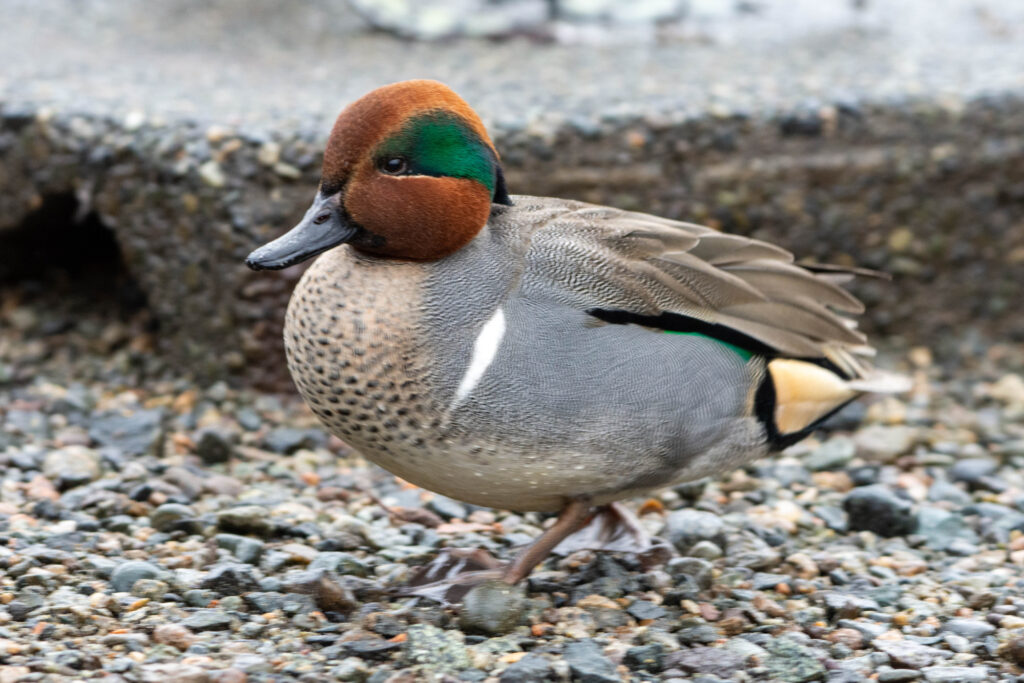There is no debate: Montana is gorgeous!
Home to national parks, state parks, rivers, mountains, grasslands, and prairies, Montana is beloved by tourists and residents alike. The state is full of incredible wild animals and fascinating birds, too!
If you find yourself near Montana’s waterways, you’re likely to see a variety of ducks. There are more than 20 species of ducks that either visit or reside in the state, either year-round or for a few months out of the year.
Many birders enjoy identifying ducks because there are so many rewards and challenges to this birding activity. Beginner birders can learn to identify some of the flashy and attention-grabbing ducks in Montana and then advance to ducks that are more subdued in appearance.
To differentiate between different ducks, you’ll need to look at their appearance, whether or not they migrate, the region where they are found, their unique sounds and vocalizations, and any behaviors that are unique to their species.
We’ve put together this list of some of the ducks you’re most likely to see in Montana. This list will let you know what to look for, listen for, and pay attention to as you locate and identify the state’s incredible ducks.
Montana’s Two Kinds of Ducks: Dabbling and Diving
There are two main categories of ducks:
- Diving ducks (also called sea ducks), who submerge themselves completely to find food at the bottom of the water
- Dabbling ducks, who simply dip their head under the water and stretch their necks to get food, leaving their tails bobbing along the surface
The behaviors and habitats of dabbling and diving ducks are different enough that we’re differentiating between them for this article. You will see a label next to each duck, identifying it as either a dabbling or diving duck.
Let’s get started – in alphabetical order, here are 20 of the ducks you might see in Montana!
American Wigeon (Dabbling Duck)

- Scientific Name: Mareca americana
- Length: Up to 14 inches
- Weight: About 2.25 pounds
- Wingspan: 34 inches
You’ll find American Wigeons throughout most of Montana during the breeding season, which lasts from the middle of May to the middle of August. They live year-round in southwest Montana, including Helena, Butte, and Big Sky.
These small, compact ducks travel south and southeast for their non-breeding season, settling in most of the United States, Mexico, Central America, and the northern edge of South America.
Males are easier to identify than females, as they have an iridescent green band that runs from their eyes around to the back of their heads. They also have a thick, white crown.
Females, on the other hand, have brown bodies and gray heads. Both sexes are small and compact, and they both have a black-tipped, blue-gray bill.
Interesting fact about American Wigeons: These breathtaking ducks will follow behind other ducks that are migrating and steal their food from them.
Blue-Winged Teal (Dabbling Duck)
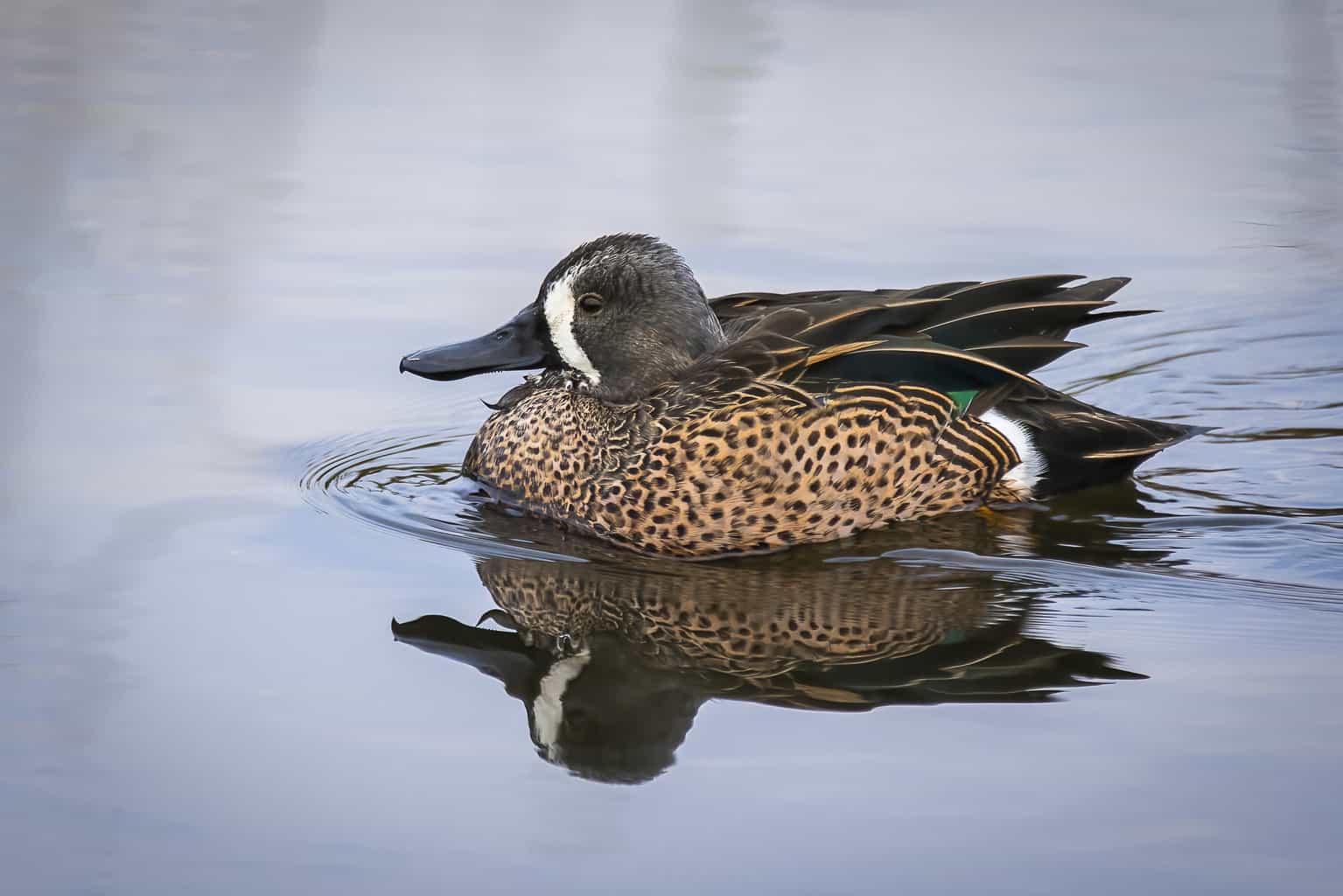
- Scientific Name: Anas discors
- Length: 16 inches
- Weight: 13 ounces
- Wingspan: 23 inches
The Blue-Winged Teal Duck is found throughout Montana during the breeding season, which lasts from late April to early May. They migrate very late in the spring and then migrate south earlier than almost any other duck.
The appearance of a Blue-Winged Teal Duck is dependent upon both sex and season.
During the breeding season, adult males are mostly brown, and their breast is speckled in brown and cream. The male’s head is blueish-gray, and he has a white patch near his tail, as well as a thick white stripe down his face.
Then, after the breeding season ends, he loses his color and takes on the appearance of a female or juvenile male. Females and non-breeding males have plain brown feathers and a blue wing patch, which is only seen if they are in flight.
They choose a summer habitat of ponds, small lakes, marshes, and rivers. If there is a lot of grassland next to the water, such as a prairie or meadow, that’s definitely an appealing sight to the Blue-Winged Teal Duck.
Interesting fact about Blue-Winged Teal Ducks: They are the second most populous duck in North America, coming in second only to Mallards. Their breeding range is huge, covering most of the United States and a large portion of Canada.
Bufflehead (Diving Duck)
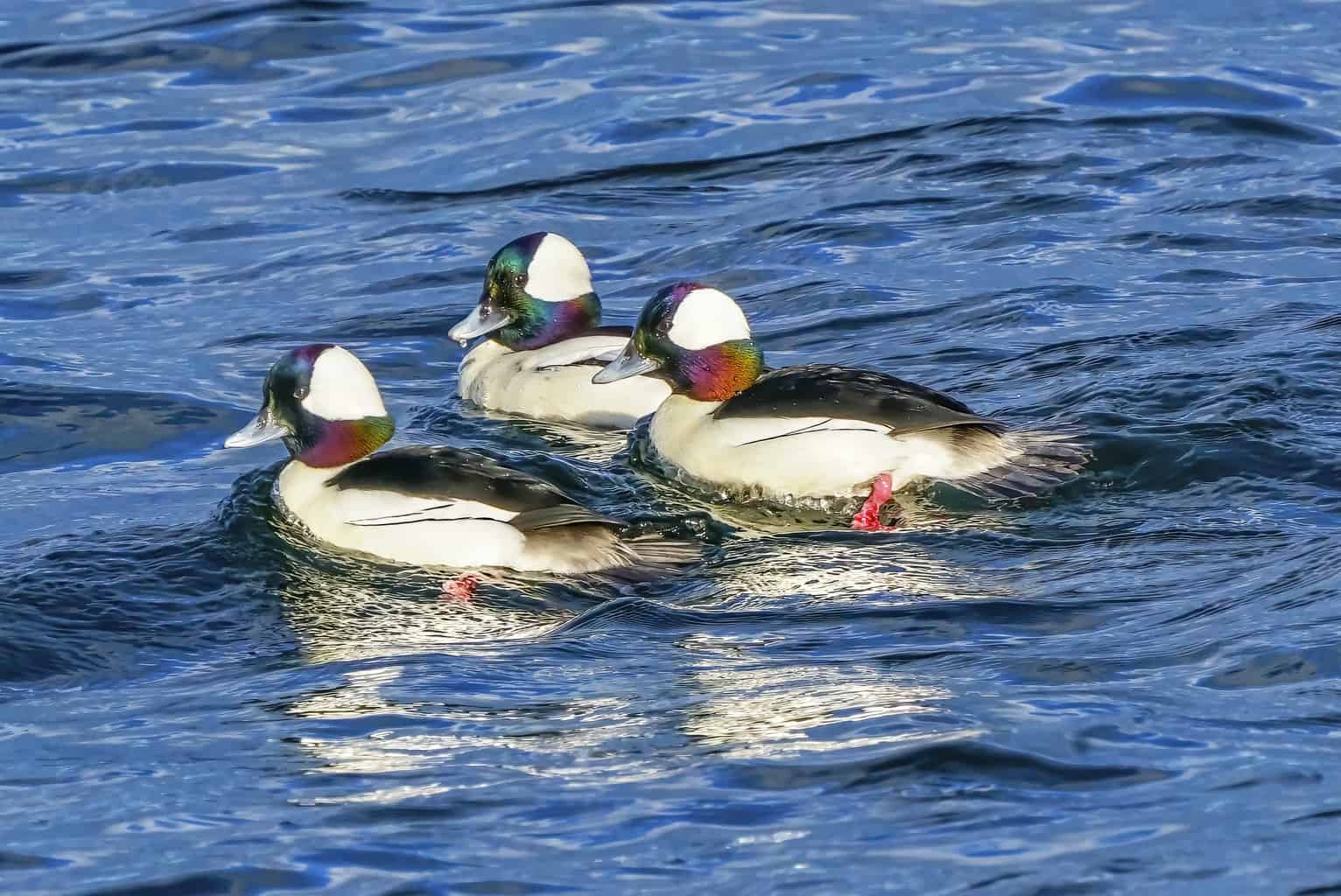
- Scientific Name: Bucephala albeola
- Length: 13-16 inches
- Weight: 11-16 ounces
- Wingspan: 22 inches
You know how buffalos have big, fluffy heads? That’s exactly where the Bufflehead gets its name; it’s shorthand for buffalo-head!
Males have a vibrant white body, black back, and iridescent head that is both green and purple. They have a very large, white, fan-shaped patch on the back of their head. Juveniles and females are much plainer, with brownish-gray bodies. They also have a cheek patch, but it’s a small oval.
Whether or not you’ll see one in Montana depends a lot on what part of the state you are in, and when.
They live year-round in Southwest Montana and Glacier Country. Most of Central Montana only sees Buffleheads during the winter. Finally, they migrate through Missouri River Country and Southeast Montana.
They are cavity dwellers, often taking over the abandoned nests of Northern Flickers. They feed on aquatic invertebrates and prefer shallow lakes, ponds, and slow-moving rivers.
Interesting fact about Buffleheads: These are the smallest diving ducks in North America.
Canvasback (Diving Duck)
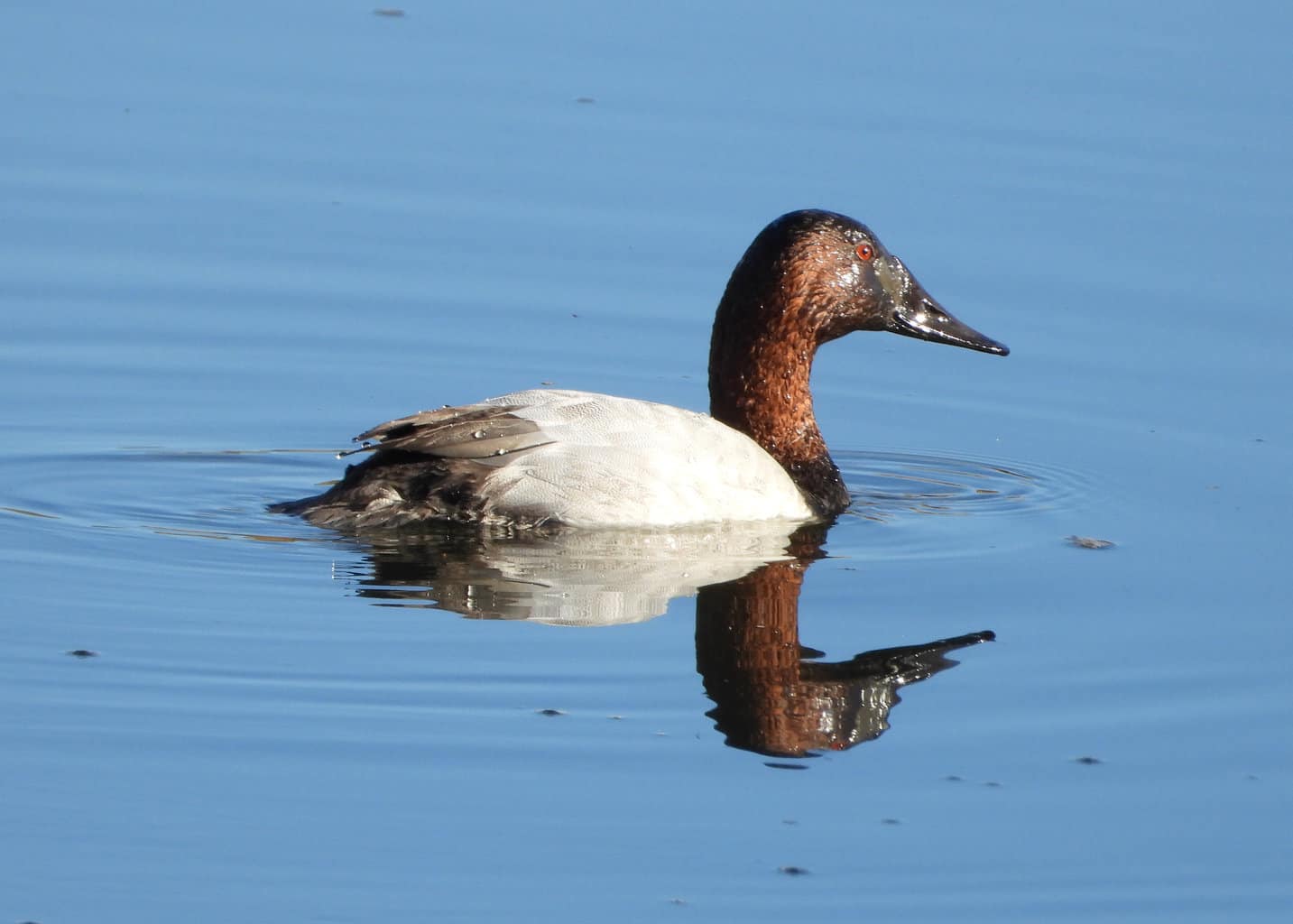
- Scientific Name: Aythya valisineria
- Length: 13-16 inches
- Weight: Up to 2.5 pounds
- Wingspan: Up to 3 feet
The Canvasback duck has a thick neck, big head, and long bill. Males are black, white, and brown. Females have a similar tri-colored pattern, but they are just a bit paler. An additional distinguishable difference between them is that males have red eyes and females have black eyes.
You will not find the Canvasback in the southern or eastern regions of Montana. During the breeding season, however, they can be found in Glacier Country and the northern edge of the state.
These speedy ducks can fly up to 72 miles per hour, which is nearly 30 miles faster than the average duck.
Interesting fact about Canvasbacks: Canvasback ducks practice a form of brood parasitism, where they lay their eggs in other ducks’ nests. However, they typically only lay their eggs in the nests of other Canvasbacks, rather than other kinds of ducks. They will also raise the ducklings of Ruddy Ducks and Redhead Ducks, both of whom will lay eggs in Canvasback nests.
Cinnamon Teal Duck
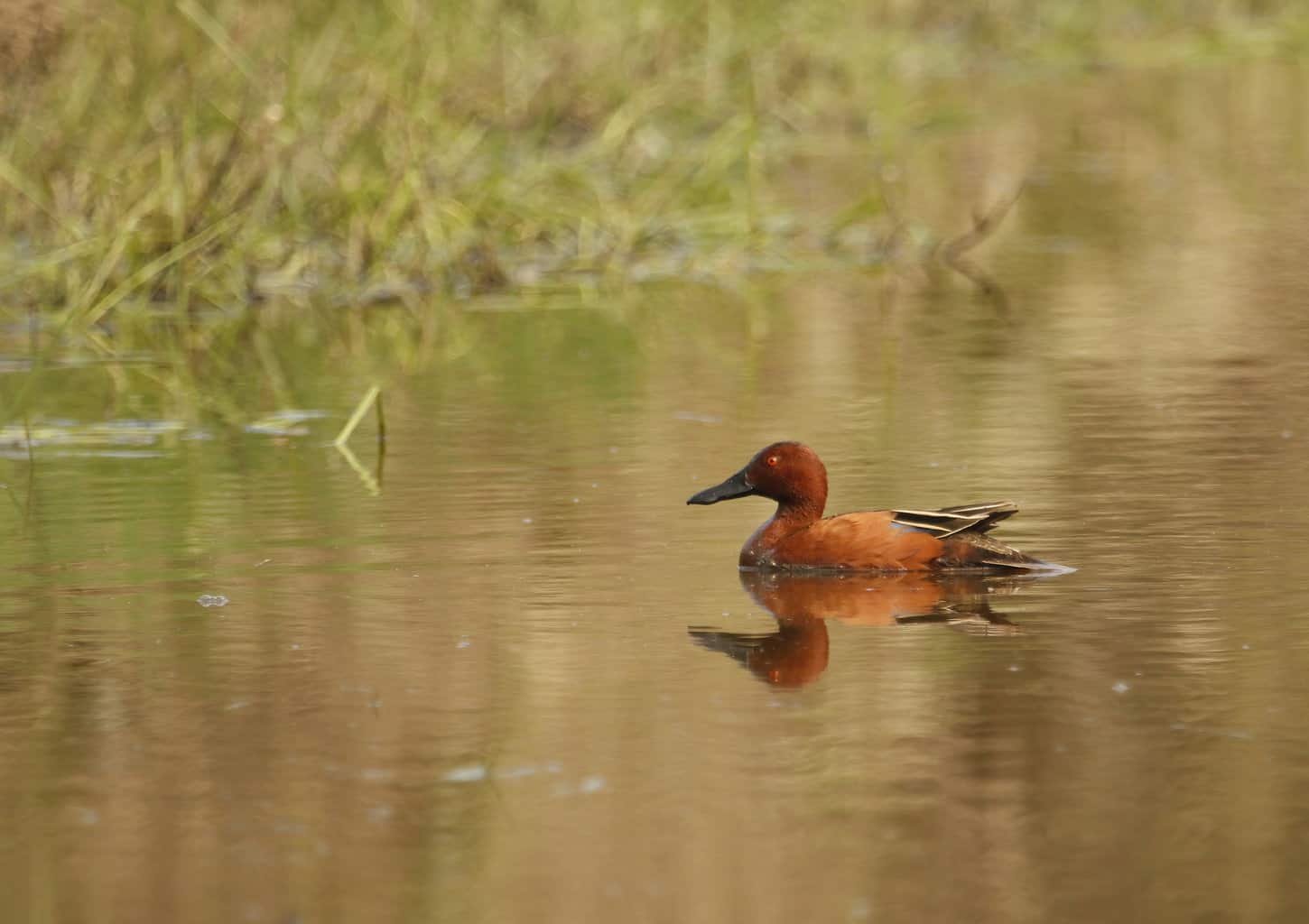
- Scientific Name: Spatula cyanoptera
- Length: 11 inches
- Weight: 12.6-18.2 ounces
- Wingspan: 25 inches
Cinnamon Teal Ducks are quite stunning, especially breeding-season males.
Breeding males have a deep, rusty brown head, neck, breast, and shoulders. Their primary feathers are brown and black, and their secondary feathers are green.
Nonbreeding males, females, and juveniles are mostly brown, with some course mottling in darker brown. No matter the sex, all adult Cinnamon Teal Ducks have a sky-blue patch on their shoulders.
Birders in Montana are lucky – they get to see the gorgeous breeding-season plumage of the males! Cinnamon Teal Ducks arrive in Montana by mid-April to late May and then leave in the fall.
Interesting fact about Cinnamon Teal Ducks: Many ducks are cavity dwellers, but Cinnamon Teal Ducks build nests in the grasses in the wetlands. Females are able to conceal their nests under dead grasses and vegetation. She will create tunnels through the grasses to access her nest, staying almost undetectable all the while!
Common Goldeneye (Diving Duck)
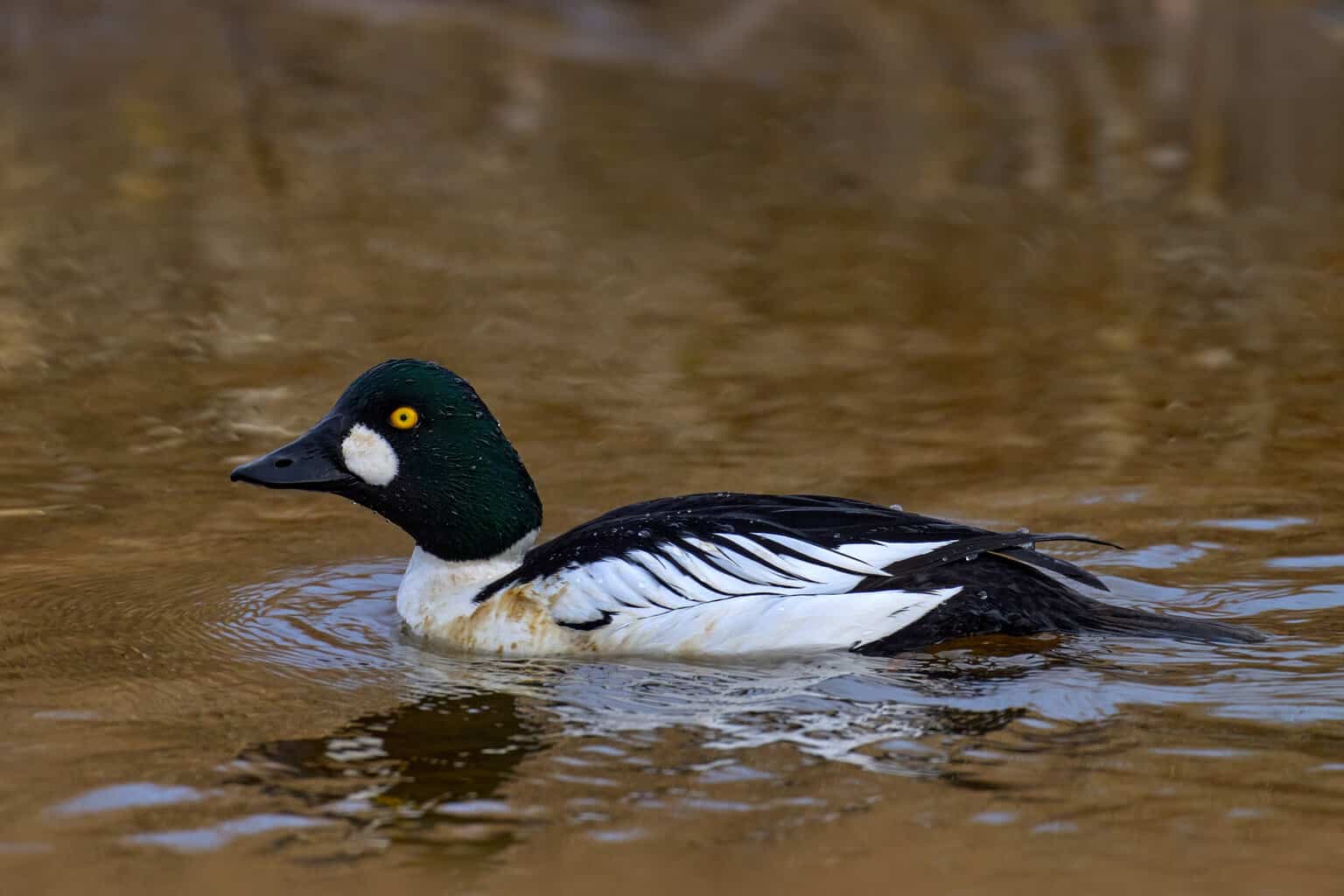
- Scientific Name: Bucephala clangula
- Length: 16-20 inches
- Weight: Approximately 1.8 pounds
- Wingspan: 30.3-32.7 inches
Even from a distance, you may be able to spot the Common Goldeneye’s signature yellow eyes.
Other than those bright yellow eyes, female and breeding male Goldeneyes have little in common. Breeding males are green and white, but their green feathers are so dark that they are often mistaken for black and white. He has a small white cheek patch, as well as another white patch on his wings.
Females, on the other hand, are gray-bodied and have brown heads. The female has no cheek patch, but she does have a white patch on her wings, just like the breeding male. During the winter, males lose their dramatic coloring and look about the same as females.
The Common Goldeneye’s breeding ground covers most of Canada, and they winter across the entire US, except for southern Texas and parts of the southeast.
In Montana, you will find these ducks with pretty eyes on large lakes and rivers. In the western half of the state, you might be lucky enough to see them year-round. Meanwhile, in eastern Montana, you will only see them during the winter.
Interesting fact about Common Goldeneyes: Common Goldeneye females are not the most attentive mothers. It’s not uncommon for females to abandon their ducklings right after they have hatched, leaving them to try to find another female to “mother” them. In addition, female ducks are prone to fighting, and their ducklings may scatter and be unable to find their mother again. These collections of ducklings from different broods are called creches.
Common Merganser (Diving Duck)
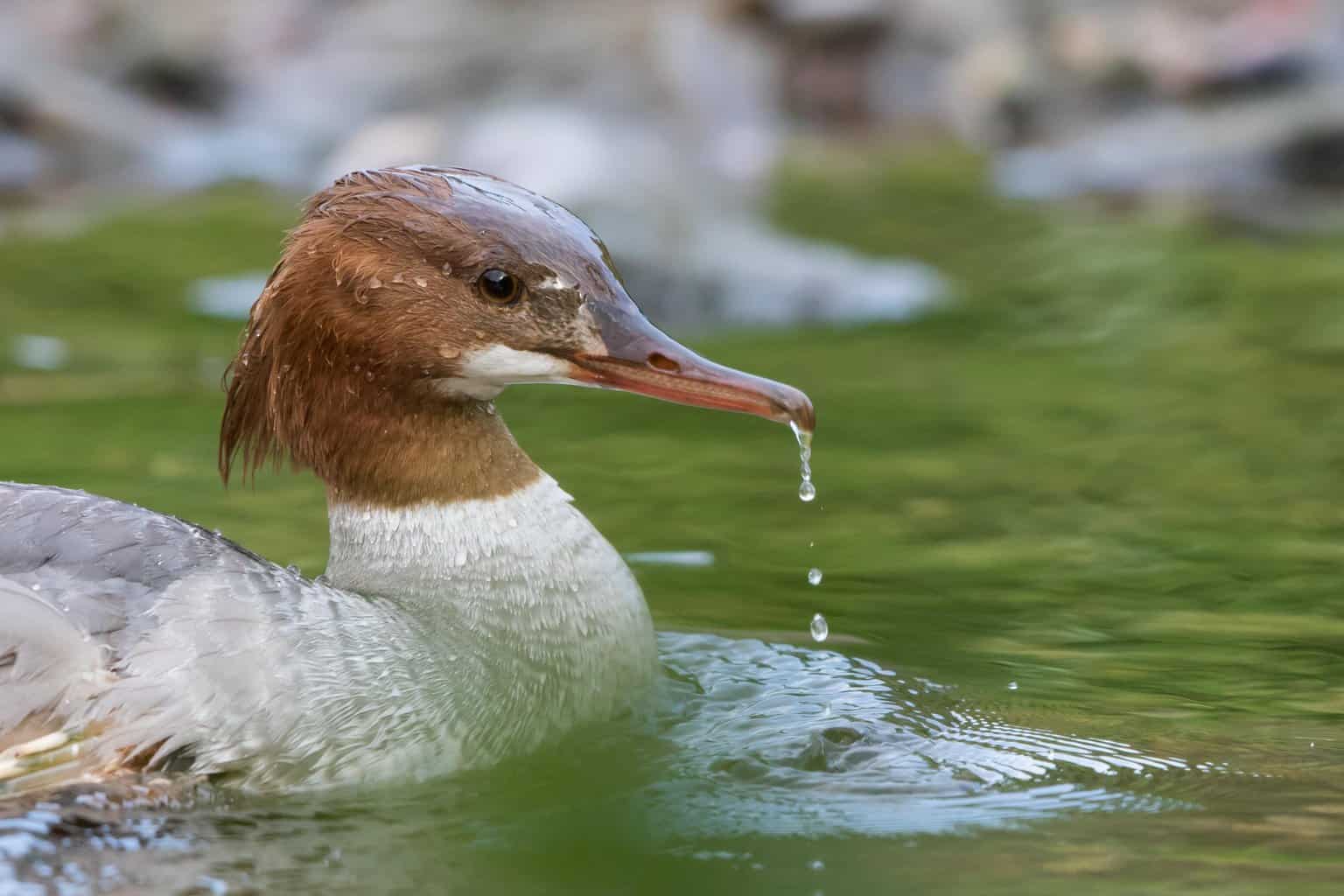
- Scientific name: Mergus merganser
- Length: 21.3-27.9 inches
- Weight: 31.8-76.2 ounces
- Wingspan: 33.9 inches
The Common Merganser is Montana’s most common duck. It can be found year-round in most of Montana’s woodland rivers and lakes. In Southeast Montana and the eastern edge of Missouri River Country, the Common Merganser is only a winter visitor.
Common Merganser breeding males have a metallic green head, a bright white body, and a black back. The male’s red bill is black-tipped. Non-breeding males look like females, but only for a brief period: typically late summer to the middle of fall.
The female has a dark cinnamon-colored head and a gray body. She has a defined line on her neck where her coloring changes suddenly from brown to gray.
Interesting fact about Common Merganser: Common Mergansers are so good at fishing that other birds – including gulls and even bald eagles – will follow them around in order to swoop down and steal the fish right from their bills!
Gadwall (Dabbling Duck)
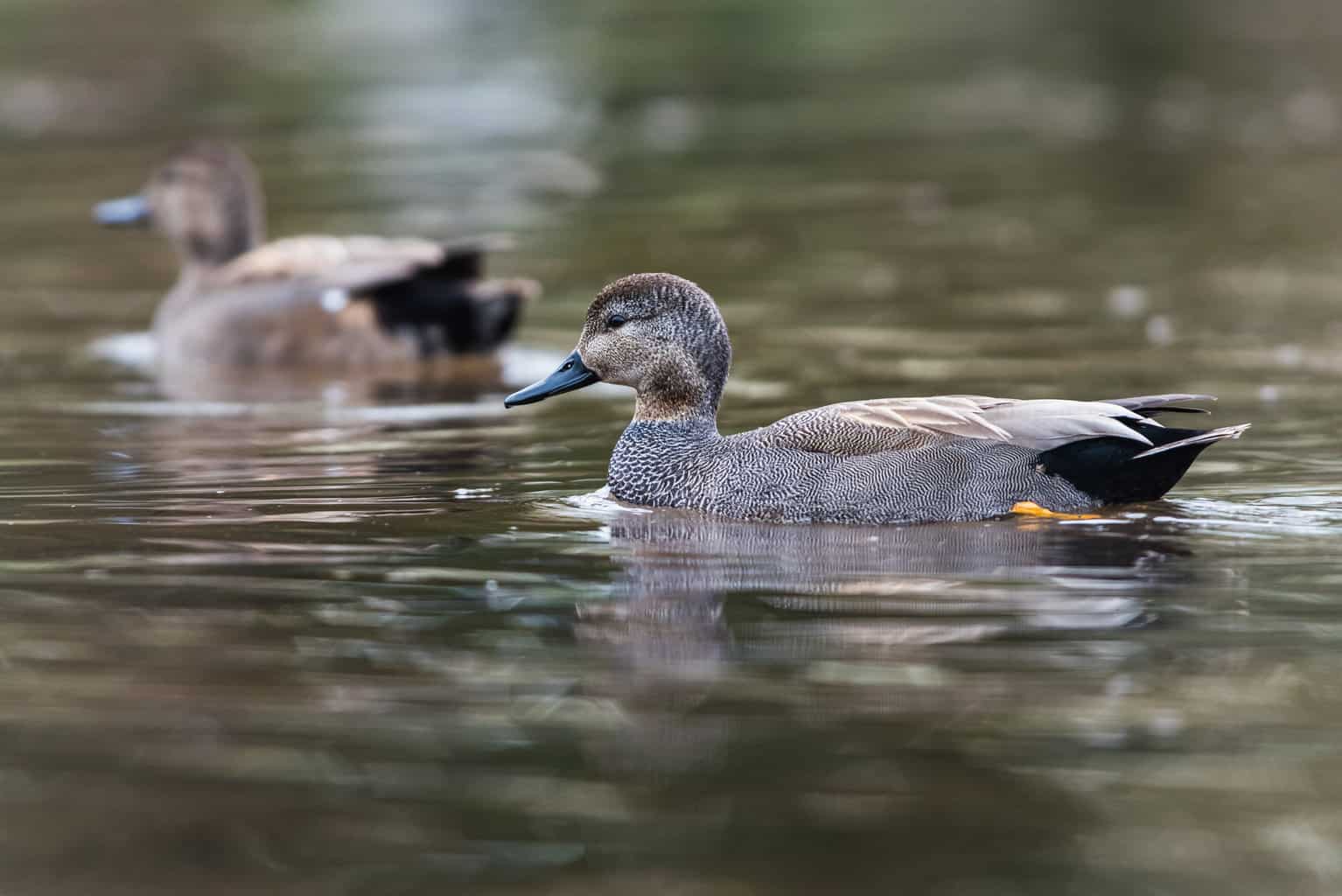
- Scientific Name: Mareca strepera
- Length: 18.1-22.4 inches
- Weight: 17.6-44.1 ounces
- Wingspan: 33.1 inches
Western Montana, including Glacier Country, sees Gadwall Ducks year-round. They can be found in eastern Montana during the summer. Some Gadwall will simply stop briefly in Montana as they migrate to other regions.
Their heads are square-ish, in contrast to their thin necks and bills.
Both males and females are fairly muted when compared to the vibrant colors of other ducks. Males are gray and green; females are light brown and creamy white. Both males and females have a white wing patch that can be seen when they are on the water.
Interesting fact about Gadwall Ducks: They are thieves! Like the American Wigeon, Gadwall Ducks are sneaky. They will wait for diving ducks to return to the surface after a dive, and they will steal their food away from them.
Green-Winged Teal (Dabbling Duck)
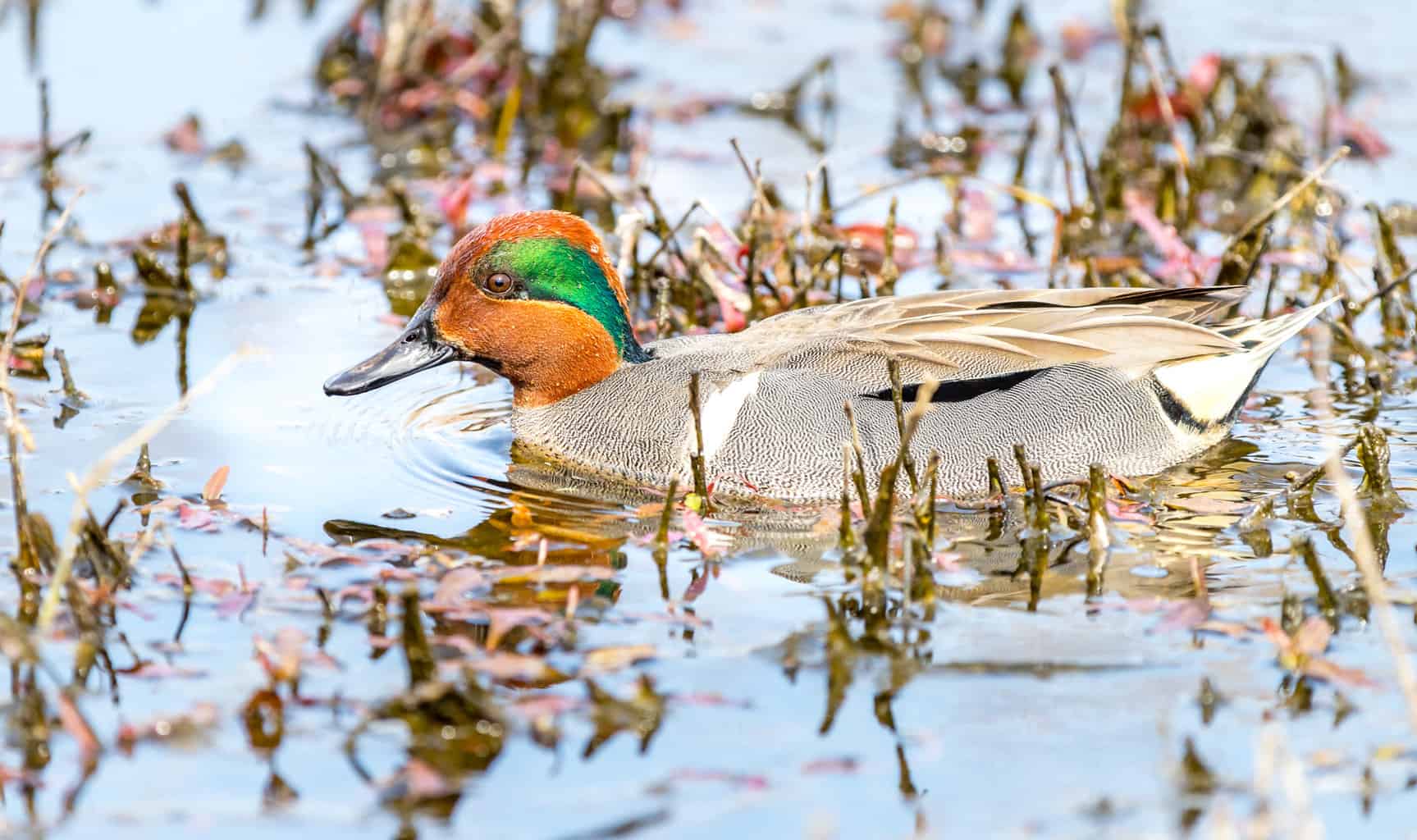
- Scientific Name: Anas carolinensis
- Length: 12.2-15.3 inches
- Weight: 4.9-17.6 ounces
- Wingspan: 20.5-23.2 inches
The male Green-Winged Teal Duck has an iridescent green stripe from his eyes to the back of his coppery-brown head.
Females are more muted in their appearance, with brown and light brown barring over most of their feathers.
Both males and females have metallic green speculum. A “speculum” is a stripe of colorful feathers on the secondary wing feathers of a duck. They can be seen in flight, but are usually not visible when they are sitting, standing, or swimming.
Green-Winged Teal Ducks are the smallest dabbling duck found in North America. You’ll find them year-round in the western half of Montana, including both Glacier Country and Southwest Montana. In the east, you will only find them during the summer breeding season.
Their habitat includes rivers, marshes, estuaries, wetlands, and flooded agricultural areas.
Interesting fact about Green-Winged Teal Ducks: During the breeding season, Green-Winged Teal Ducks gather in huge groups. They can be found in flocks with up to 50,000 other ducks!
Harlequin Duck (Diving Duck)
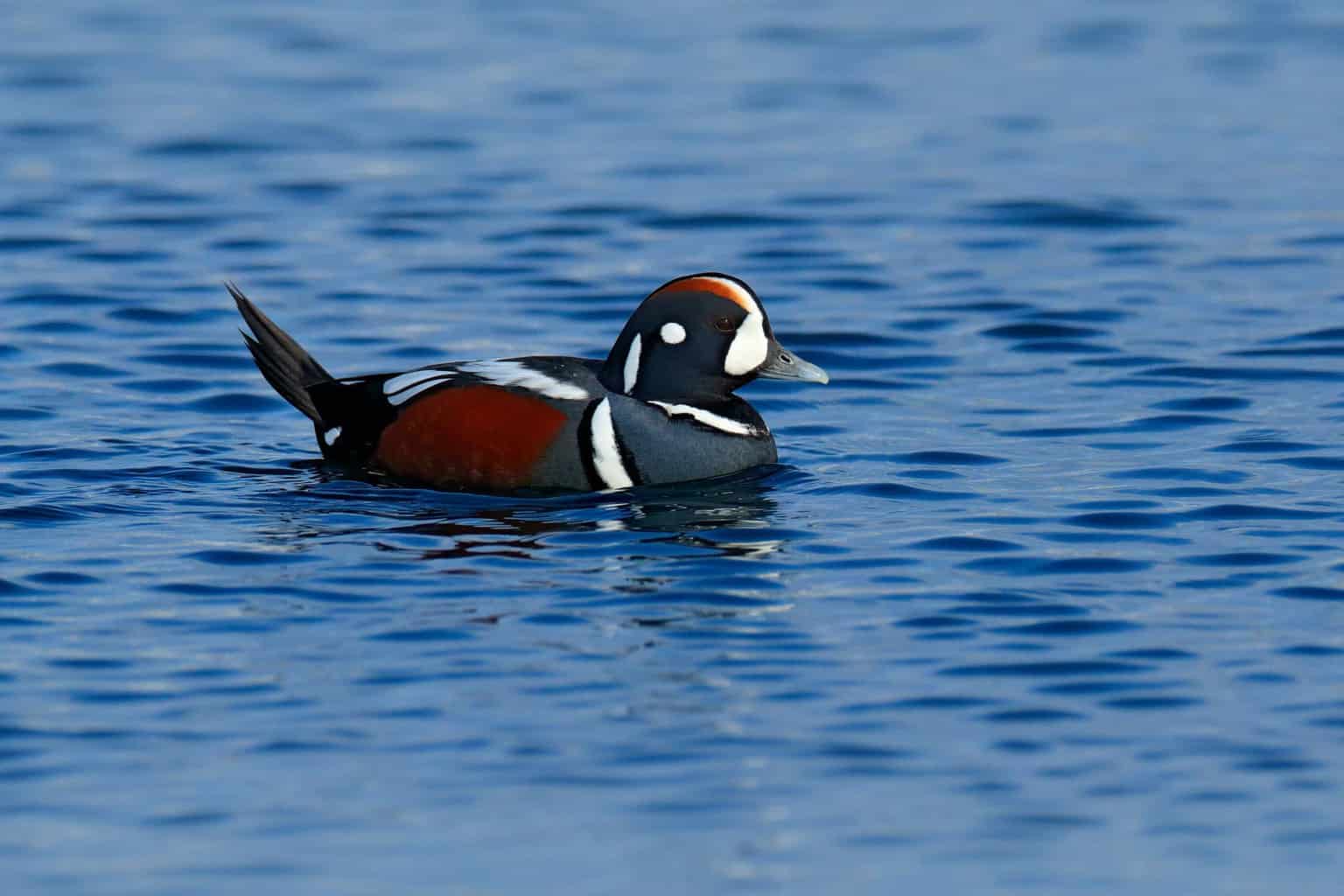
- Scientific Name: Histrionicus histrionicus
- Length: 13.4-18.1 inches
- Weight: 17.3-26.8 ounces
- Wingspan: 22.1-26.0 inches
There aren’t many Harlequin Ducks in Montana. If you’re lucky enough to see one, it will likely be along a small stream. They nest within a few feet of the streambed, which means that flooding is a major threat to their well-being.
Western Montana is the very southeastern edge of the Harlequin duck’s Pacific coast breeding range. During the non-breeding season, they migrate to the far northern Pacific coast of Canada and Alaska.
Male Harlequins have a striking appearance during the breeding season, which is when you will see them in Montana. The breeding male’s head is very dark blue (or black), with a crescent-shaped mark in front of his eye. He also has brown and white stripes on his face. He has a dark blue body, chestnut-brown sides, and some white stripes.
Non-breeding males lose some of their patterns and markings, but they are very dark brown and blue.
Females are brown with pale faces. Near the back of their head, they have a small white patch.
Interesting fact about Harlequin Ducks: Studies of Harlequin Ducks have discovered that they often experience broken bones and even head trauma. This damage to their bodies comes from the rough waters where they live.
Hooded Merganser (Diving Duck)
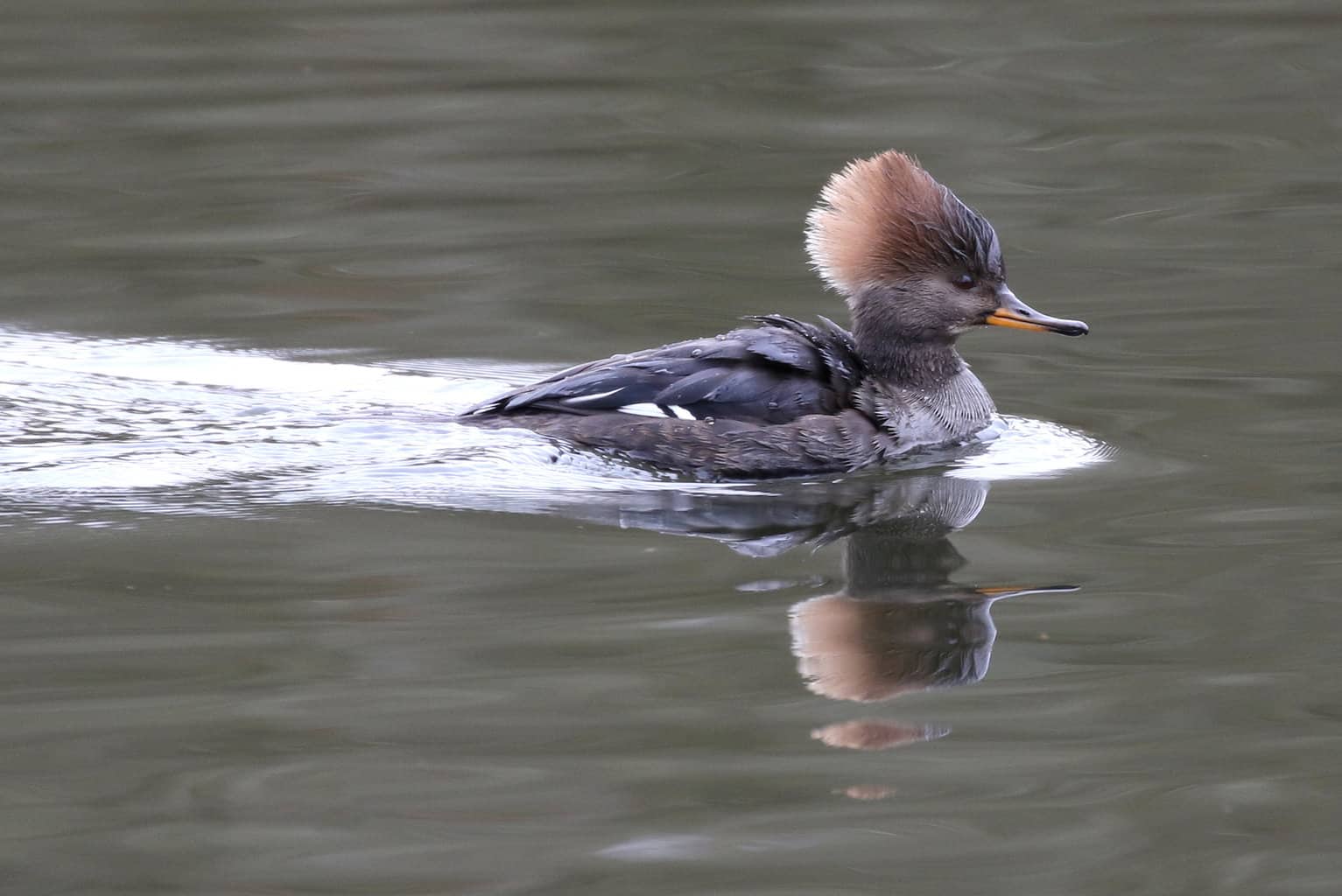
- Scientific Name: Lophodytes cucullatus
- Length: 15.8-19.3 inches
- Weight: 16-31 ounces
- Wingspan: 23.6-25 inches
During the breeding season, you might hear a Hooded Merganser before you see one! These ducks are sometimes called “frog-ducks” because the breeding call of the male sounds like a pickerel frog’s low-pitched croak.
When you see one in person, you’re in for a treat! All adult Hooded Mergansers have very dramatic crests. The male’s crest is a contrasting black and white. The white portion is the shape of a fan that changes in size depending on whether the crest is raised or lowered.
The female’s crest is reddish-brown, and her body is brown and dark brown.
Many Hooded Mergansers migrate through Montana every year, and the western edge of the state sees Hooded Mergansers year-round. They can be found in freshwater ponds, lakes, and rivers. They spend the winter on larger bodies of water, including both freshwater and saltwater.
Interesting fact about Hooded Mergansers: These ducks have an important feature that protects their eyes while they are swimming underwater and looking for food: a nictitating membrane. This thick, transparent extra eyelid operates like a pair of goggles, protecting the duck’s eyes while providing clear vision underwater.
Lesser Scaup (Diving Duck)
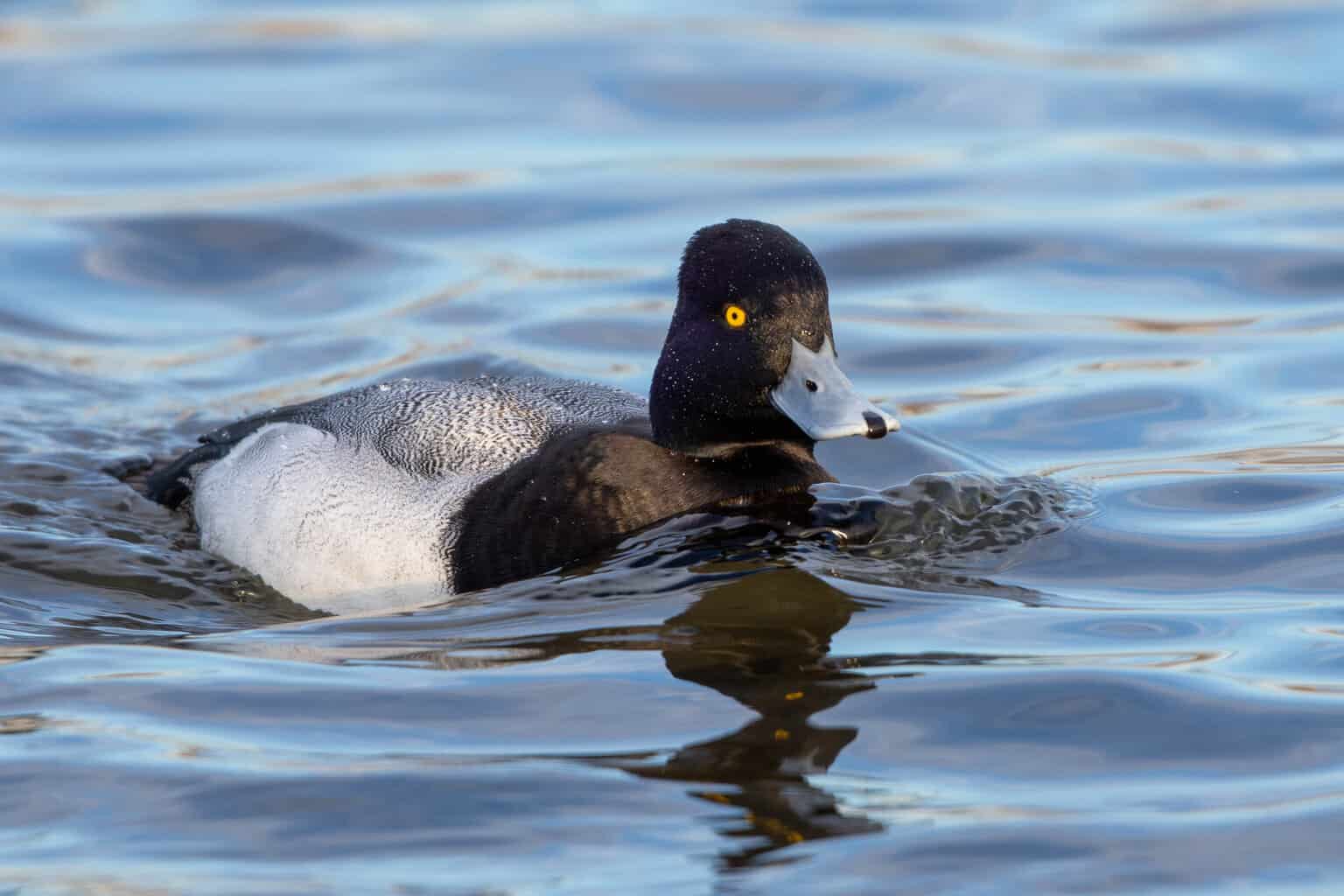
- Scientific Name: Aythya affinis
- Length: 15.3-18.1 inches
- Weight: 16-38.4 ounces
- Wingspan: 26.8-30.7 inches
There are two types of Scaup: Greater and Lesser. Only the Lesser Scaup is present in Montana, though.
Lesser Scaup can be found year-round in the western part of the state. During the summer breeding season, they visit eastern Montana.
Greater and Lesser Scaup have a lot in common, but identify the Lesser Scaup by looking for its egg-shaped head as a giveaway.
Males are described as black and white, but they are really very dark green or purple and white. Females are light brown with dark brown heads.
Interesting fact about Lesser Scaup: There are more Lesser Scaup in North America than any other diving duck! There are nearly 4 million Lesser Scaup spread across the continent.
Mallard (Dabbling Duck)
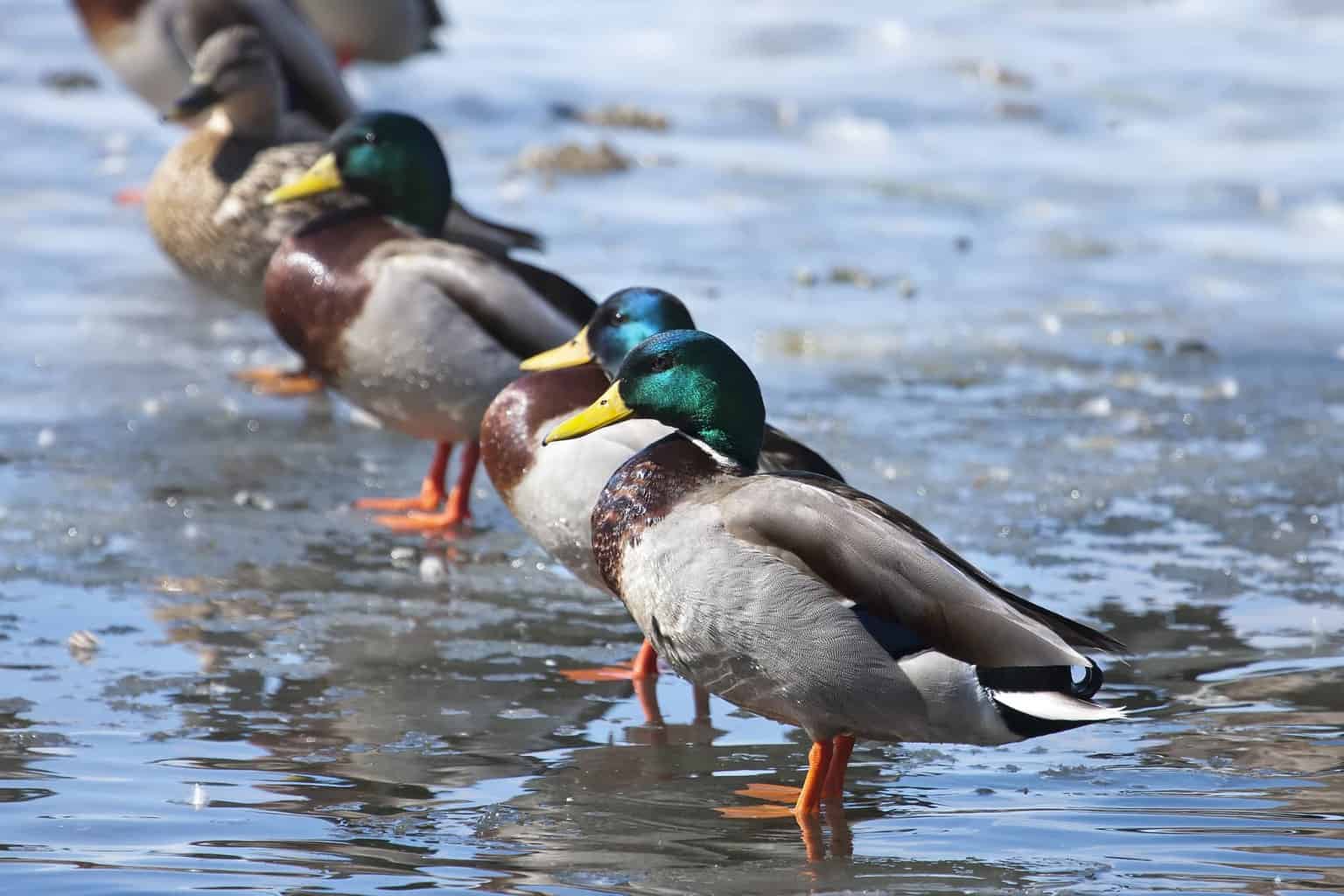
- Scientific Name: Anas platyrhynchos
- Length: 20-26 inches
- Weight: 1.5-3.5 pounds
- Wingspan: 32-39 inches
The Mallard is incredibly iconic. Found in Europe, Asia, and Africa, the breeding male Mallard has a dark, metallic green head. He also has a thin white ring around his neck, a brown breast, a mostly gray body, and a black tail.
His head keeps some of its green coloring when he loses his breeding season appearance, but the rest of his body changes to brown.
Females, on the other hand, look the same year-round. Her feathers are streaked in dark and light brown.
Mallards live in just about every wetland habitat, from marshes and floodplains to lakes and reservoirs. You’ll find them in both rural farmlands and city parks.
In Montana, Mallards are year-round residents.
Interesting fact about Mallard Ducks: Mallards are the common ancestor of nearly every domestic breed of duck, as they are prone to interbreeding with other ducks they encounter.
Northern Pintail (Dabbling Duck)
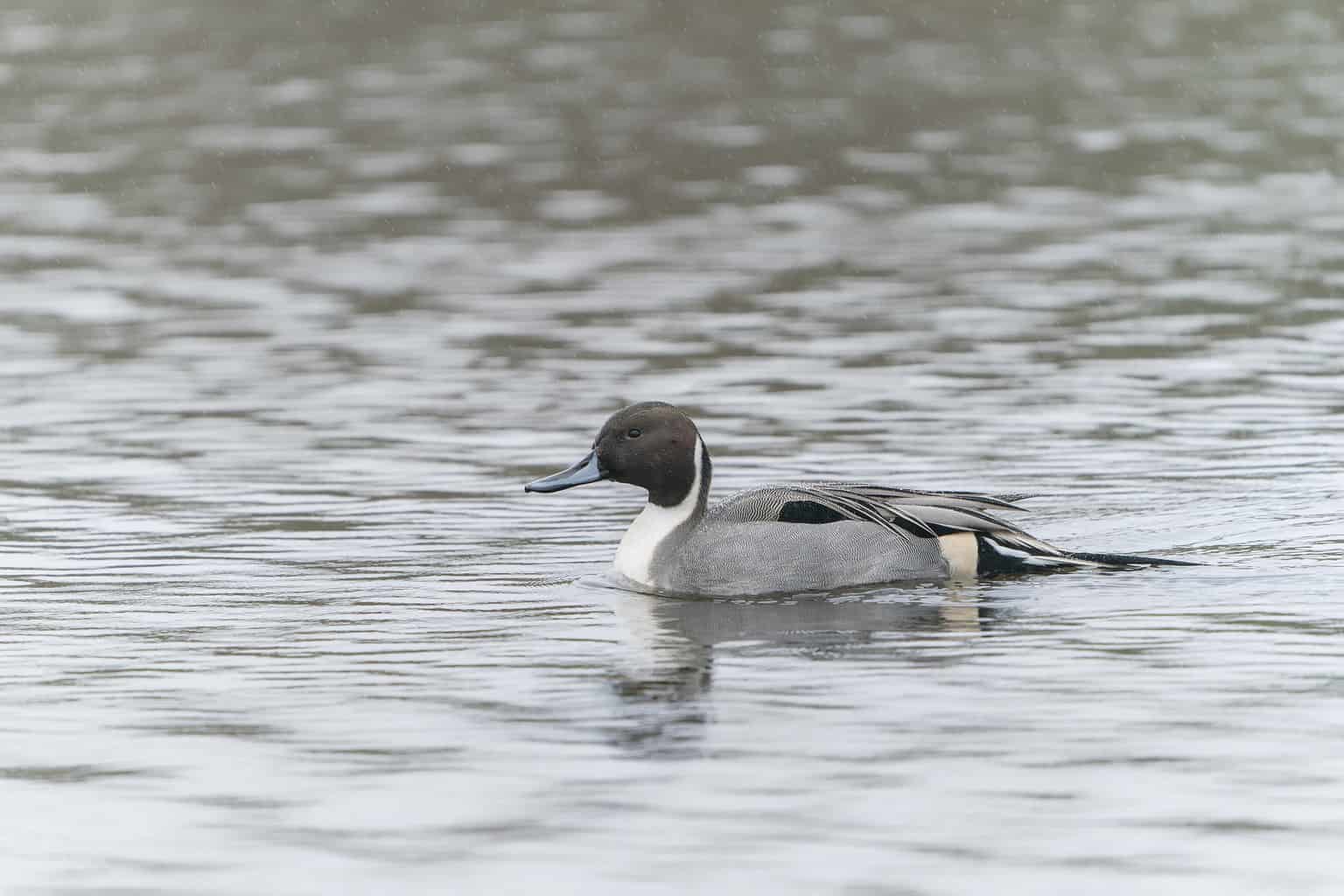
- Scientific Name: Anas acuta
- Length: 20-30 inches
- Weight: 1-3 pounds
- Wingspan: 20-30 inches
Northern Pintails have a substantial range. During the breeding season, they can be found throughout almost all of Canada, as well as in Western states like Montana, North Dakota, South Dakota, Idaho, and more.
In some of Montana, they are year-round residents, but in most of the state, they are breeding season-only inhabitants. They migrate distances, up to 1800 miles, from as far as northern Canada to the southern tip of Mexico. Their flight speed reaches up to 48 miles per hour.
During the breeding season, you can easily spot the male Pintail’s long, thin, pointed tail feathers. This tail only appears on the adult breeding male, not on females, juveniles, or non-breeding males.
Males and females alike have a colorful speculum; his is metallic green, and hers is metallic brown. Otherwise, females are quite plain, without any dramatic markings on the face or neck.
The Pintail’s diet is made up of aquatic plants, seeds, grasses, and small water-dwelling animals. They live along most kinds of waterways and wetlands, including lakes, ponds, safely protected coasts, marshes, and agricultural lands.
Interesting fact about the Northern Pintail: Pintails may be dabblers, but their long necks allow them to reach deeper into the water than their fellow dabbling ducks.
Northern Shoveler (Dabbling Duck)
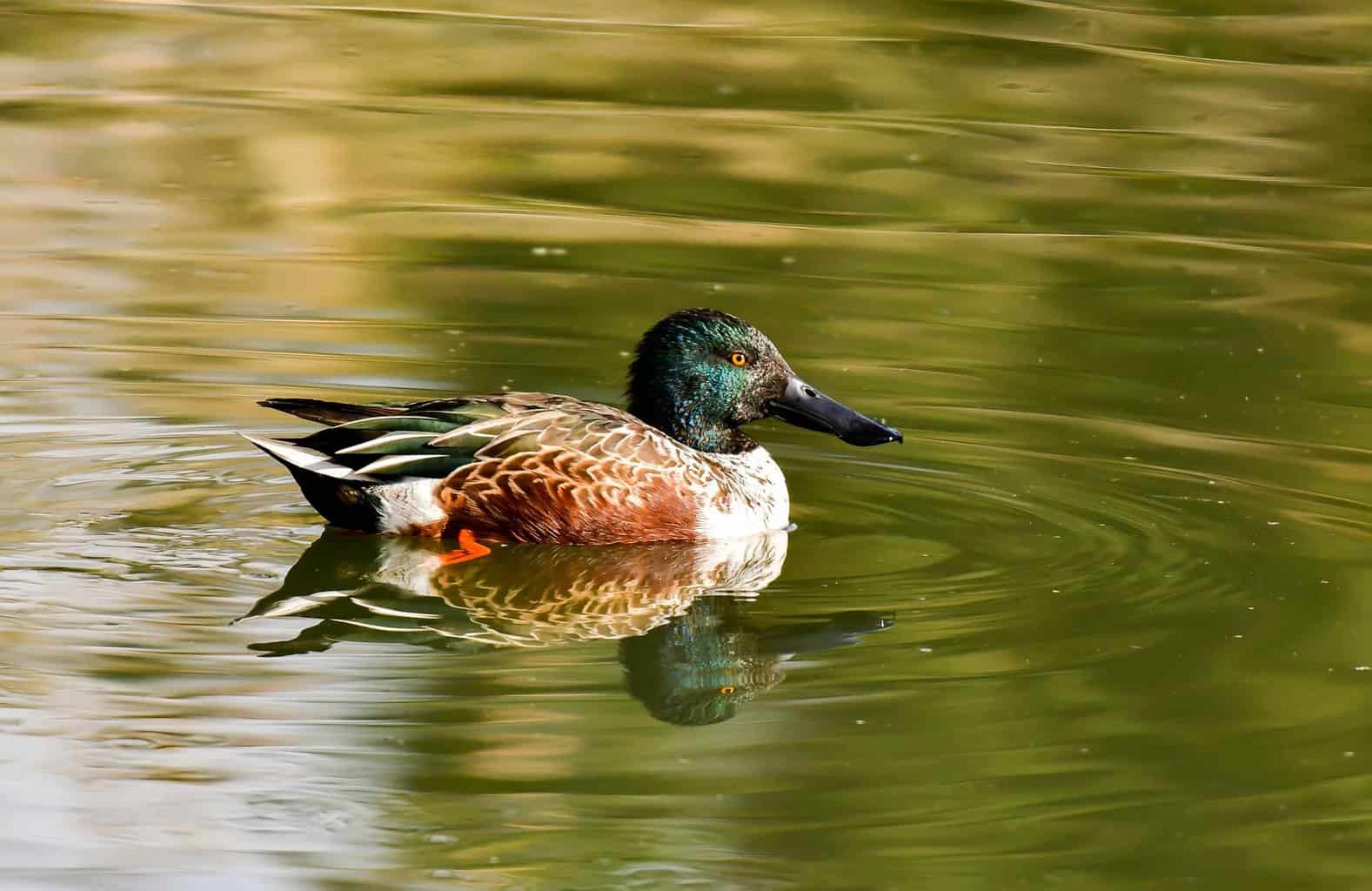
- Scientific Name: Spatula clypeata
- Length: 19 inches
- Weight: 1.3 pounds
- Wingspan: 30 inches
The Northern Shoveler gets its name from its shovel-shaped bill, which is thick and broad. The bill’s coloring is based on sex; females have a bright orange bill and males have a dark black bill.
The breeding season male has a green speculum and a dramatic, dark green head. His wings are metallic brown and light blue, and large portions of his body are whiteish-gray.
Females and non-breeding males look alike but are easily differentiated based on bill color.
Northern Shovelers are not unique to North America. They are also found in India, across a wide swath of Europe, and in parts of Africa.
Interesting fact about Northern Shovelers: These ducks do something gross, but effective! When under attack or startled in their nests, females will flee the scene to safety, but not before defecating all over their nests, including their eggs. This creates an unappealing mess for predators and protects her ducklings!
Red-Breasted Merganser (Diving Duck)
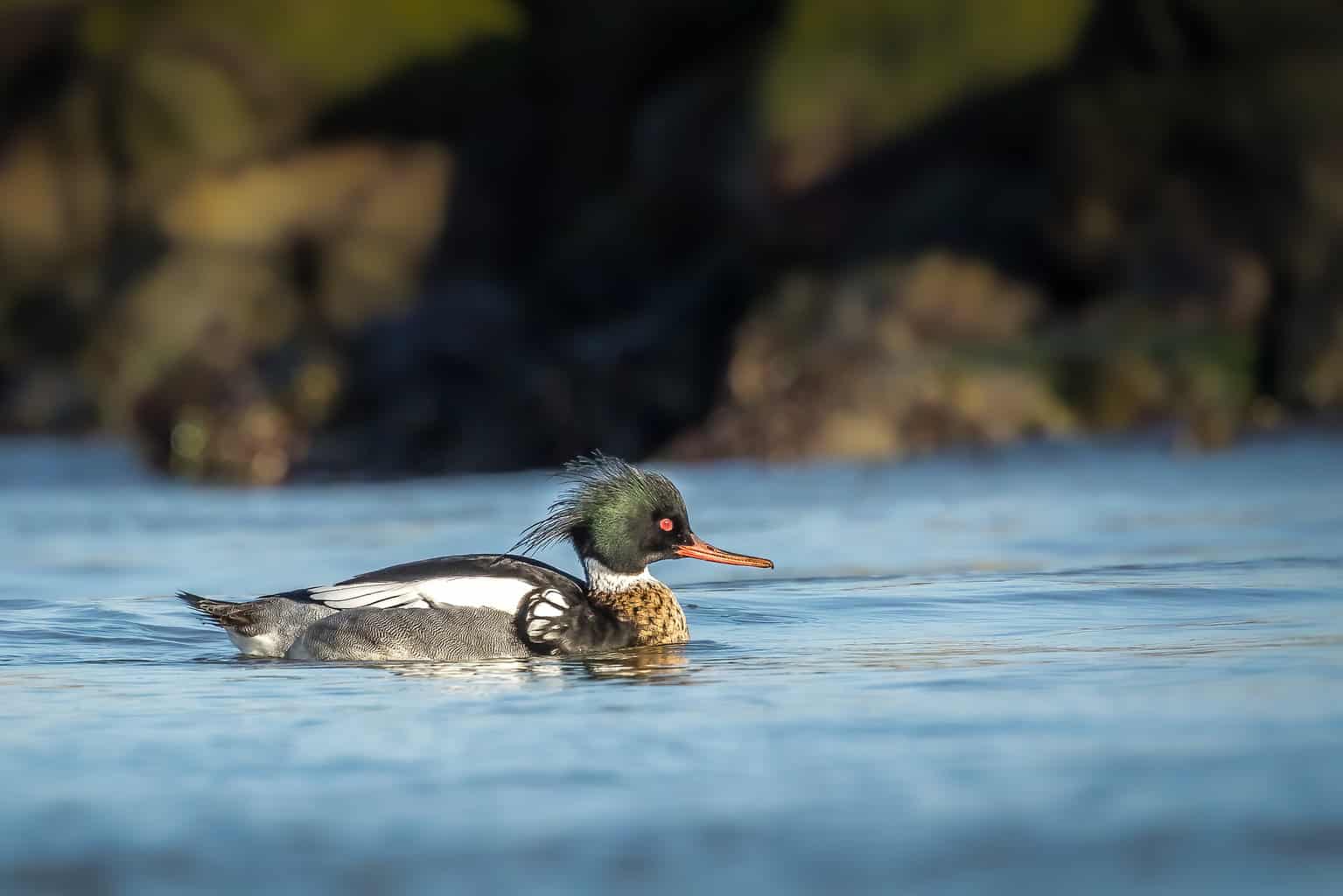
- Scientific Name: Mergus serrator
- Length: 20-24 inches
- Weight: 2.3 pounds
- Wingspan: 28-34 inches
Red-Breasted Mergansers have a shaggy head that differentiates them from many other ducks. The long feathers on their heads give them an interesting silhouette.
The female has a warm brown head, a plain grayish body, and an orange bill. The male has a dark green (almost black!) head, a thick white neck ring, a cinnamon-red chest, and a white, black, and gray body.
Red-Breasted Mergansers don’t spend much time in Montana. They travel through the state as they migrate between their Canadian breeding territories and coastal winter environments. You are most likely to see them gathering in large groups, especially in the Bozeman area, in late April or late October.
Red-Breasted Mergansers have a preference for saltwater, which is why their winter habitat is exclusively coastal. However, they will nest and live along freshwater if that is what is available.
Interesting fact about Red-Breasted Mergansers: In flight, Red-Breasted Mergansers have been measured flying up to 81 miles per hour. After a running start, they take off into the air and fly faster than just about any other kind of duck.
Redhead (Diving Duck)
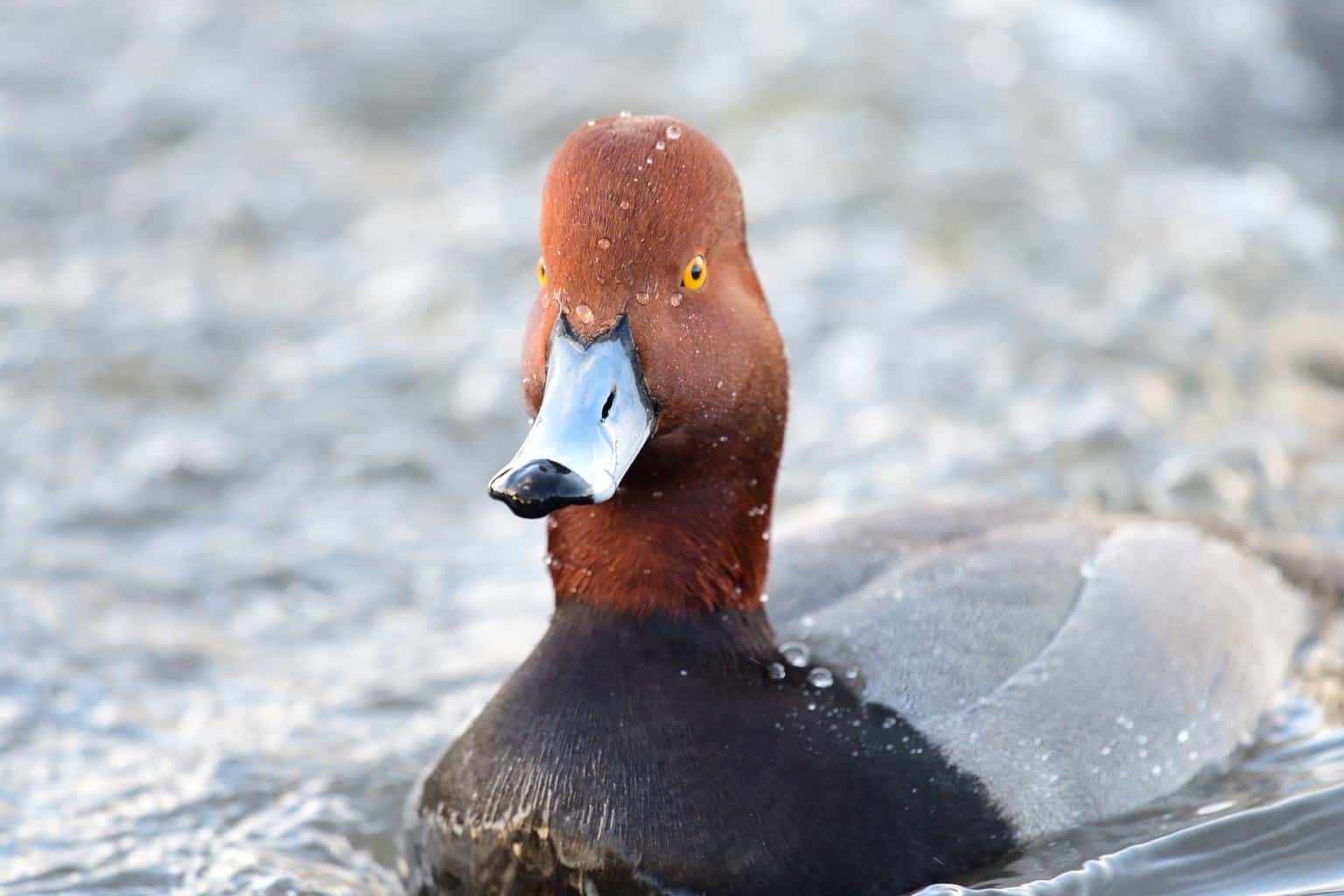
- Scientific Name: Aythya americana
- Length: 18-22 inches
- Weight: 2-2.5 pounds
- Wingspan: 33 inches
The male Redhead duck has a dark and vibrant cinnamon-brown head and an all-black chest. They are easy to recognize because of these bold markings, even from quite a distance.
Female Redheads are a bit harder to identify, thanks to minimal markings and a plain, light brown body. Both males and females have gray flight feathers and rounded heads.
In Montana, Readhead ducks are less likely to be found in woods and forested areas and more likely to inhabit slow-moving lakes. They spend the breeding season throughout much of the state, including where there are plenty of dense grasses along open waters.
Interesting fact about Readhead ducks: Redheads partake in brood parasitism, which is when they lay their eggs in the nests of other ducks. They mostly stick to the same species, laying their eggs in other Redhead nests. However, they will also lay eggs in the nests of other ducks, most frequently Canvasbacks. These eggs may or may not survive to the point of hatching.
Ring-Necked Duck (Diving Duck)
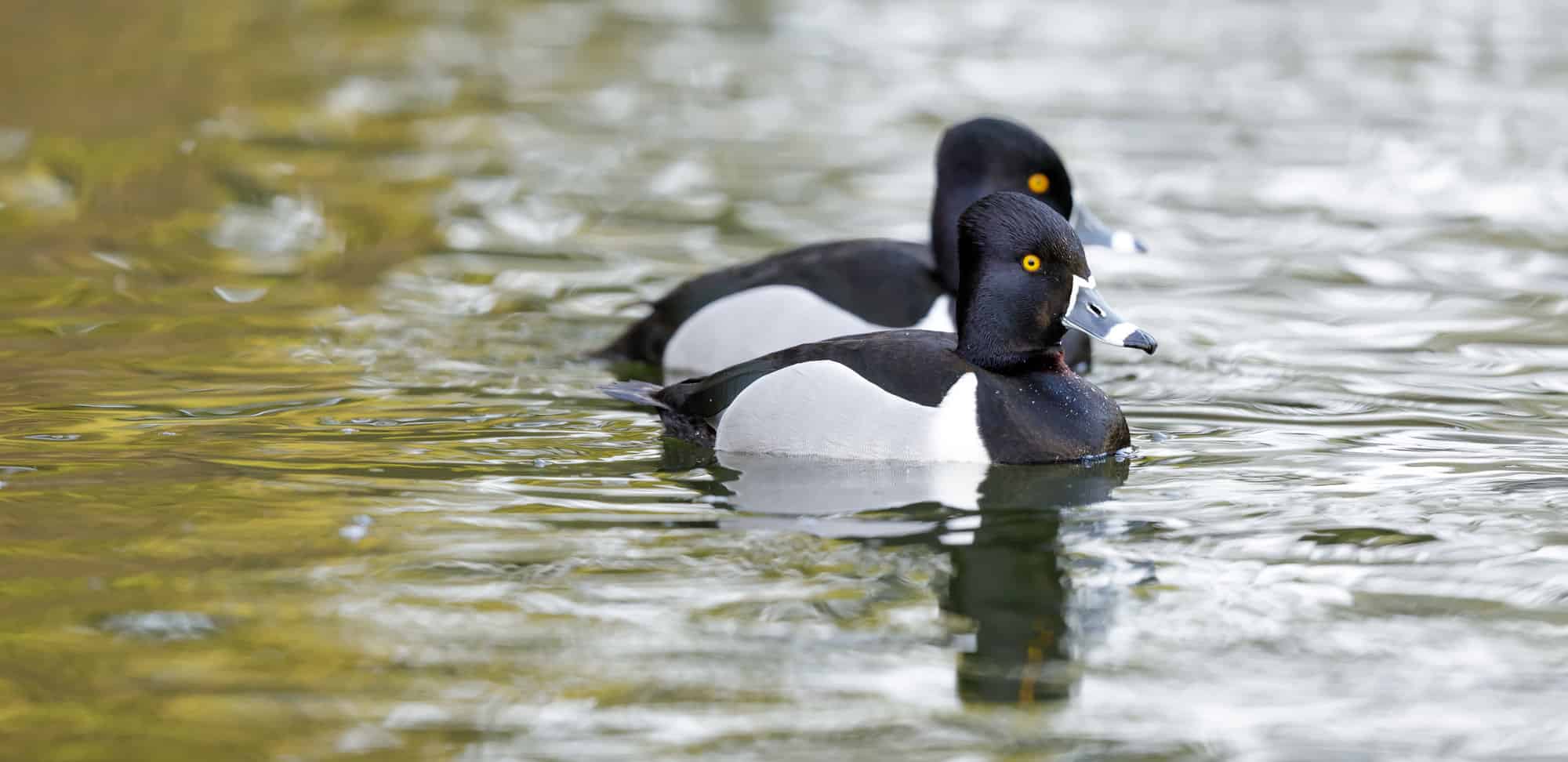
- Scientific Name: Aythya collaris
- Length: 15.3-18.1 inches
- Weight: 17.3-32.1 ounces
- Wingspan: 24.4-24.8 inches
Despite the name, Ring-Necked Ducks do not have an obvious ring around their necks. They do have a cark copper ring around their neck, but it is barely noticeable. That’s because Ring-Necked Ducks were named by naturalists in the 1800s who only had access to carcasses.
When a live Ring-Necked Duck is moving about in the world, that copper neck is barely visible!
However, Ring-Necked Ducks do have a white ring around the bill. Their foreheads slope downwards, and they have a subtle crown. Males have black heads, black backs, and silverish-gray bodies.
Females are light and dark brown. Their faces are lightly stippled in brown and white. Both sexes have a black-tipped bill.
Even though most diving ducks prefer deeper waters, Ring-Necked Ducks aren’t deep divers. They prefer shallow ponds and marshes. They generally only visit Montana during their migration between Canada and southern states.
Interesting fact about Ring-Necked ducks: Some ducks need a running start to take flight, but Ring-Necked ducks are able to take off directly from the water. This helps them fly off quickly when there is a predator or threat nearby!
Ruddy Duck (Diving Duck)
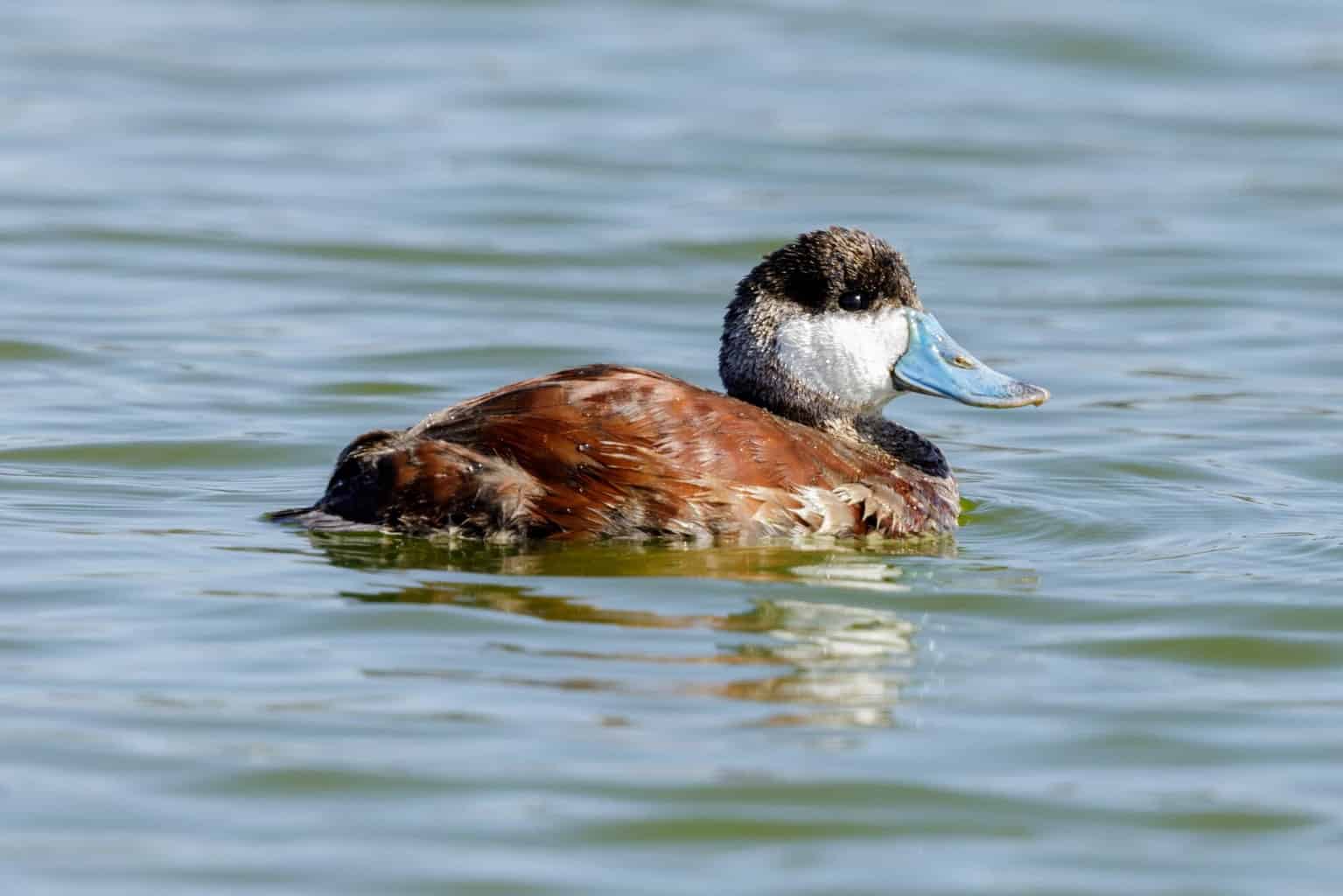
- Scientific Name: Oxyura jamaicensis
- Length: 13.5-17 inches
- Weight: 1.23 pounds
- Wingspan: 18.5 inches
Ruddy Ducks have a bright blue bill – but only in the summertime. Non-breeding season males and females have bills that are all black. Because Ruddy Ducks are only found in Montana during the summer, watch for that blue bill when you’re differentiating Ruddy Ducks from other diving ducks.
The Ruddy Duck male also has a long, pointed tail during the breeding season, which he loses in the fall. Breeding and non-breeding males have a large white cheek patch.
Females and juvenile males are mostly grayish-brown.
From Montana, Ruddy Ducks migrate to the west coast, east coast, or Gulf Coast. They leave Montana between mid-September and late November, and they return again between mid-April and late May.
Interesting fact about Ruddy Ducks: Ruddy Ducks are very aggressive ducks, especially males. They chase and attack other duck species and one another! They even chase off rabbits who are near their wetland habitats.
Wood Duck (Dabbling Duck)
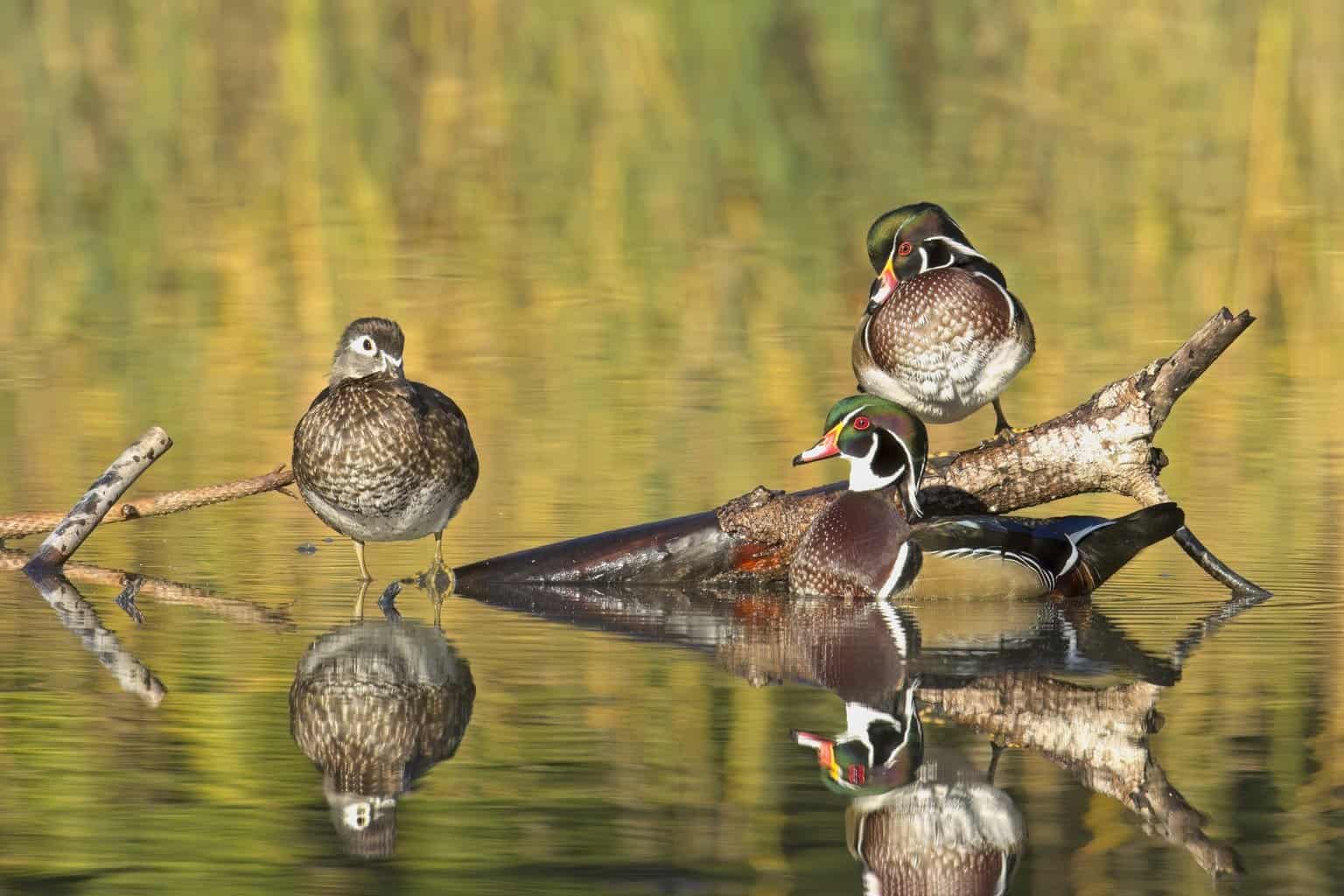
- Scientific Name: Aix sponsa
- Length: 17-20 inches
- Weight: 1.5 pounds
- Wingspan: 28 inches
The Wood Duck is incredibly easy to identify! The male’s regal head is dark metallic green with white stripes. He has a chestnut-brown breast that is spotted in white.
Females are grayish-brown and don’t feature the same extravagant patterns.
Males lose much of their coloring at the end of the summer, leaving them as a more muted version of how they look during the breeding season. However, the male maintains his multi-colored bill.
As cavity dwellers, Wood Ducks make their home in wetlands, swamps, shallow rivers, and marshes. One way to find Wood Ducks is to look for cattails! They love to hide among the cattails for protection.
They are found all year in the western half of Montana and in some parts of eastern Montana during the summer. However, there are parts of Montana, specifically the northeast and southeast, that will rarely see Wood Duck visitors.
Interesting fact about Wood Ducks: Most female ducks only lay and raise one brood of ducklings per year. Wood Ducks lay two clutches of eggs every year. They will lay their eggs in other ducks’ nests when there is a lot of competition for nesting areas.
Final Thoughts
Whether you live in Montana or find yourself visiting the state, there are so many incredible birds to identify!
It’s no wonder why Montana is known as a birder’s paradise! There are birds everywhere, including ducks, songbirds, corvids, hawks, hummingbirds, birds of prey, and more.
There is no part of Montana that isn’t home to fascinating bird life! If you are traveling to Montana, be sure to keep a list of all of the fascinating birds that you see on your travels. And if you live in the state year-round, enjoy all the birds that you have access to, including so many interesting and beautiful ducks.

